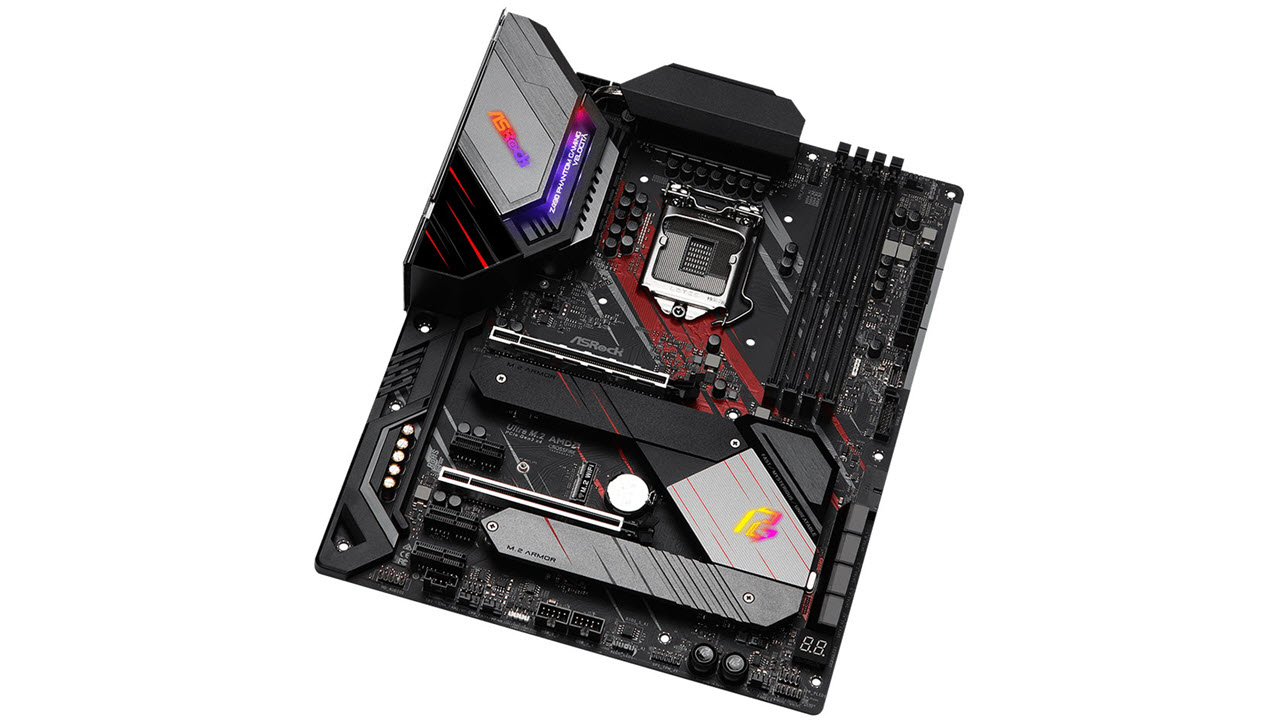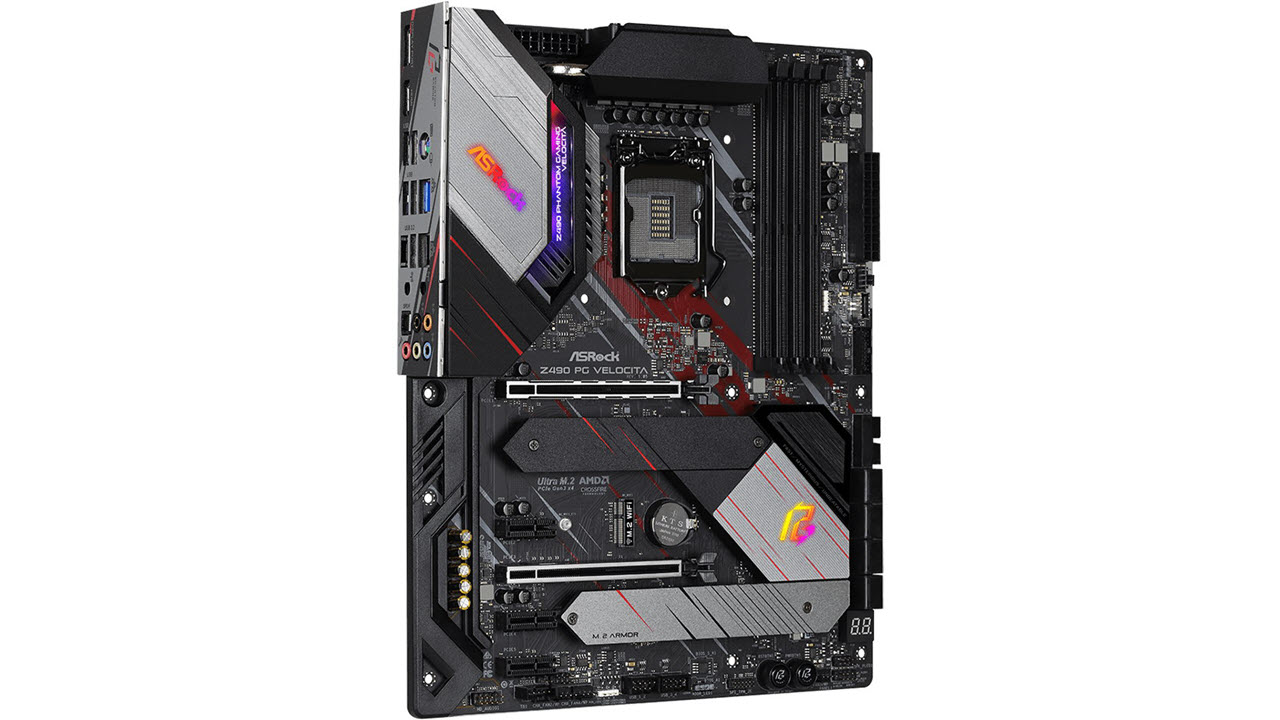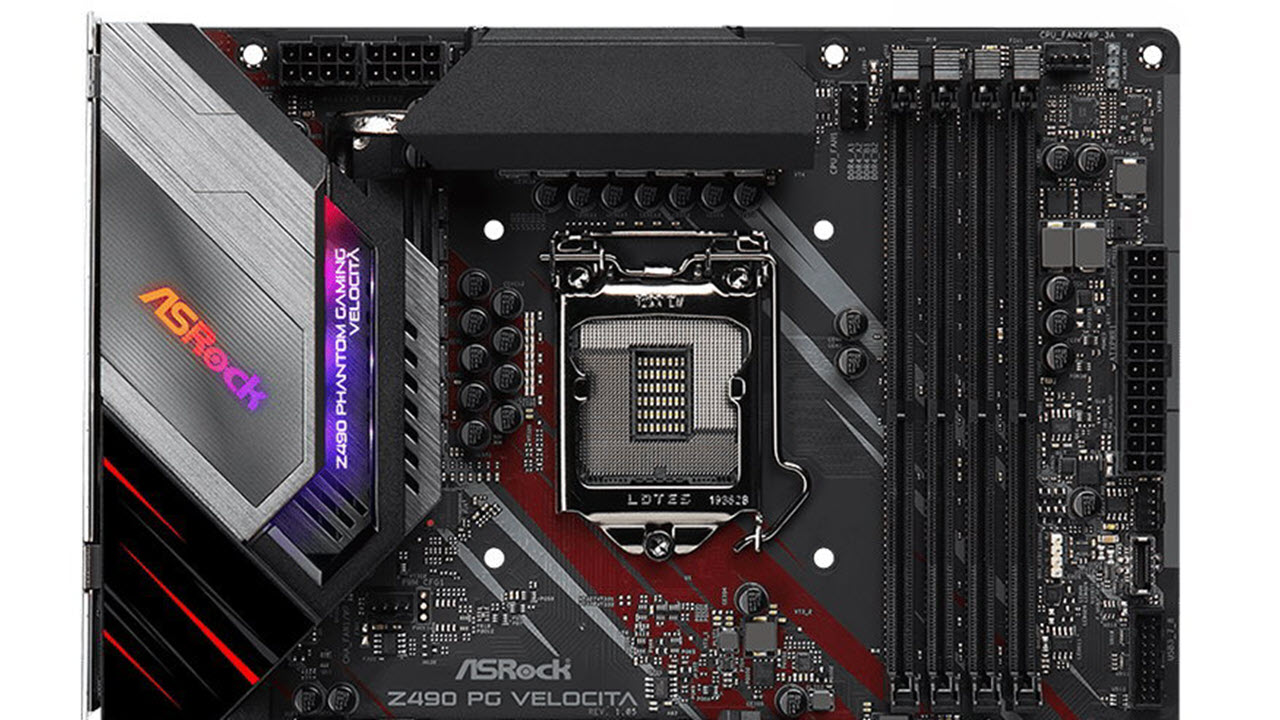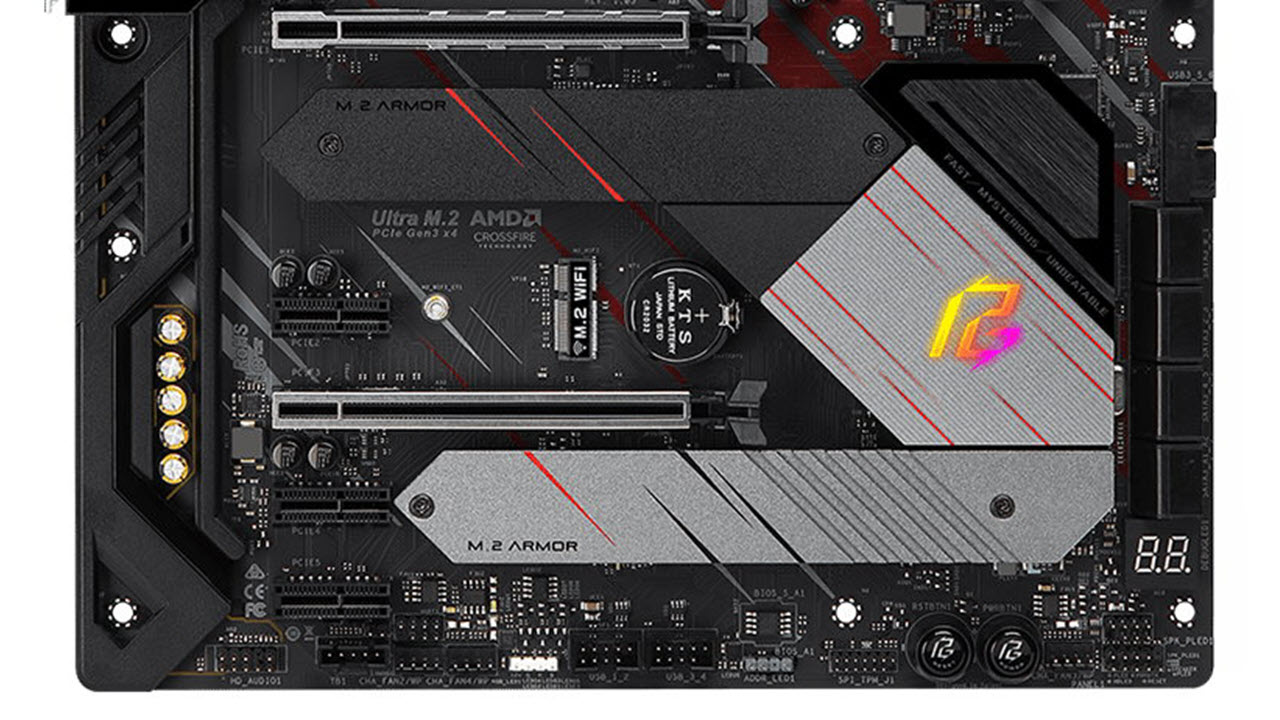Tom's Hardware Verdict
The ASRock Z490 Velocita yielded some of the best performance numbers of the five Z490 boards tested so far. With a premium Realtek audio codec, eight SATA ports, dual M.2 slots, CrossfireX support, and PCIe 4.0 support for future processors, it’s capable and well-rounded for its $259.99 price.
Pros
- +
Capable Power Delivery
- +
Large Heatsinks
- +
2.5 GbE LAN
- +
Eight SATA ports
- +
PCIe 4.0 support (with future CPUs)
Cons
- -
VRM Fans are audible out of the box
- -
No USB 3.2 Gen 2 (20 Gbps) ports/headers
- -
6 total USB ports on rear IO may not be enough for some
Why you can trust Tom's Hardware
Intel’s new 10th Generation flagship part, the Core i9-10900K, increasing the company’s mainstream core count to 10 cores with 20 threads. But without a new architecture or process node shrink (Comet Lake is still basically an iteration of Skylake on 14nm) the new cores (and higher clocks) come with additional power use as well. As we’ve seen in our high-level Z490 Motherboard Roundup, board partners have beefed up their power delivery in order to support the higher power draw, as well as integrating some new features.
This new generation of motherboards also increases price, almost in lockstep to what we observed when AMD moved from X470 to X570.
That brief state of the Intel CPU union out of the way, our first Z490-based motherboard to make it to our test bench is the ASRock Z490 PG Velocita ($259.99). This new ATX SKU hails from the Phantom Gaming line (hence the PG in the name) and sits below the flagship Z490 Aqua and Z490 Taichi. Below that is a slew of boards (11) of varying sizes, price points and features, including Mini-ITX and Micro-ATX offerings. Even the fan-favorite Extreme 4 has a Z490 variant.
The Velocita performed well, the best overall in fact, when looking at the other four boards we have tested so far. The board partners all work with an Intel specification while implementing their own boost and performance tweaks in order to stand out from the crowd. When tested with Intel’s new Core i9-10900K, the Velocita ran at 4.9 GHz on all cores during the stress test and up to 5.3 GHz (Thermal Velocity Boost, TVB) on a single thread. Other boards ran a bit slower at 4.8 GHz, but single-thread performance still briefly blipped to 5.3 GHz top stock speed where possible.
On the features front, the Velocita includes most of what we would expect of a mid-range board, offering a robust 13-phase Dr.MOS power design, including large heatsinks with three small fans attached to keep VRM temperatures down. Additionally, the board includes eight total SATA ports, dual PCIe 3.0 x4 M.2 (32 Gbps) slots, 2.5 GbE LAN and memory support listed up to DDR4 4666+(OC). Wi-Fi is not included, but an M.2 (key E) slot is available should you choose to buy a Wi-Fi / Bluetooth module separately.
Specifications
Specifications wise, the ASRock Z490 PG Velocita supports Intel 10th Generation processors. This specific board includes eight SATA ports, dual M.2 PCIe 3.0 x4 (32 Gbps) ports, and four DIMM slots capable of supporting up to 128GB of DDR4 RAM with overclocked speeds up to DDR4 4633 MHz. For networking and audio, we find a Realtek 2.5 GbE NIC and Realtek ALC 1220 audio codec which runs 7.1 surround. Below is a complete list of specifications from ASRock.
| Socket | LGA 1200 |
|---|---|
| Chipset | Z490 |
| Form Factor | ATX |
| Voltage Regulator | 12 Phase (13-phase total) |
| Video Ports | HDMI (2.0), DisplayPort (1.4) |
| USB Ports | (1) USB 3.2 Gen 2 Type-C (10 Gbps), (1) USB 3.2 Gen 2 Type-A (10 Gbps), (4) USB 3.2 Gen 1 Type-A (5 Gbps) |
| Network Jacks | (2) 1 GbE and 2.5 GbE |
| Audio Jacks | (5) Analog + SPDIF |
| Legacy Ports/Jacks | PS/2 |
| Other Ports/Jack | ✗ |
| PCIe x16 | (2) v3.0 x16 |
| PCIe x8 | ✗ |
| PCIe x4 | ✗ |
| PCIe x1 | (3) v3.0 x1 |
| CrossFire/SLI | AMD Quad CrossFireX and CrossfireX |
| DIMM slots | (4) DDR4 - DDR4 4666+(OC) |
| M.2 slots | (2) PCIe 4.0 x4 / SATA + PCIe |
| U.2 Ports | ✗ |
| SATA Ports | (8) SATA3 6 Gbps |
| USB Headers | (2) USB v3.2 Gen1 (ASMedia ASM1074), (2) USB v2.0 |
| Fan Headers | (7) 4-Pin |
| Legacy Interfaces | ✗ |
| Other Interfaces | FP-Audio, RGB-LED, Thunderbolt AIC connector |
| Diagnostics Panel | ✗ |
| Internal Button/Switch | Power / Reset |
| SATA Controllers | ASMedia ASM1061 |
| Ethernet Controllers | Intel I219-V (GbE), Realtek Dragon RTL8125GB (2.5 GbE) |
| Wi-Fi / Bluetooth | ✗ |
| USB Controllers | ✗ |
| HD Audio Codec | Realtek ALC1220 |
| DDL/DTS Connect | ✗ / ✗ |
| Warranty | 3 Years |
Included accessories for this ATX board provide most of what we’d expect and what the average consumer needs to get started. Here’s a list of what ships in the box, along with the board.
Get Tom's Hardware's best news and in-depth reviews, straight to your inbox.
- Quick Installation Guide
- Support DVD
- Four SATA cables
- Three screws for M.2 sockets
- Two standoffs for M.2 sockets
Taking a look at the board itself, the ATX size Velocita is fairly simple and tame when it comes down to styling. The PCB is mostly black with red and grey stripes slicing through the chipset area and up through the socket and left VRM bank. Other styling cues are the reinforced steel slot with its steel/silver color breaking up what would otherwise be all black cooling/shrouds. The rear IO panel is integrated matching the overarching theme black/red/silver look.
The chipset heatsink (grey and black) and left VRM heatsink (black) sport integrated RGB lighting -- the only locations on the board. On the VRM heatsink, the light shines on the shroud on the heatsink lighting up the entire area. Meanwhile, the chipset lighting is a simple frosted “PG” for Phantom Gaming. If this isn’t enough lighting, the board includes RGB headers for expansion. In the end, the Velocita should have little issue fitting in with most build themes.



Starting off with the top half of the board, the VRM banks are covered by two large heatsinks connected via a heat pipe. The VRM heatsinks also include fans in order to help keep the power delivery running cool. The top bank uses two 25mm fans while the left uses one. According to the website, these are supposed to stop for light workloads and spin up on higher loads. With the current bios (1.30A) they spin constantly (though on the Taichi, they do spin down). The design with fans, ASRock says, is intended for water cooling “to avoid mechanical conflict on certain air cooling products.” For those using air coolers, there can be potential issues due to the tall heat sinks.
Power is provided to the board by two 8-pin EPS plugs sandwiched between the VRM heatsinks. Only one EPS connector is required. Power is fed to a 13-phase VRM (10+2+1) using 60A power chokes and 50A Dr.MOS integrated power stages (Vishay SIC654). Managing the PWM is an Intersil ISL69269 (12 channel) along with a single ISL6617A doubler for the SOC stages. Between the large actively cooled heatsinks and the power bits described above, the ASRock had no issues running the i9-10900K at stock speeds.
To the right of the socket are four DRAM slots that lock on one side. Unlike the PCIe slots, the memory slots do not include the Steel Armor protection--though that’s not really a substantive omission. Memory support is listed up to DDR4 4666+(OC), with capacity up to 128 GB. We ran our 2x8GB GSkill Trident Z Neo sticks at their rated (XMP) settings of DDR4 3600 CL16 and the 2x8GB GSkill Trident Z Royale DDR4 4000 CL18 sticks without issue. Flanking the top of the DRAM slots and just above the top PCIe slot are three (of seven) 4-pin fan/water pump headers. Specifically, these are the CPU fan and CPU/Water Pump connectors, with the third labeled as a chassis header.
On the far right of the board, from top to middle, we see the first of two grey addressable RGB headers, the 24-pin ATX connector, another 4-pin chassis fan header, a front panel Type-C USB 3.2 Gen2 (10 Gbps) port along with a vertically oriented USB 3.2 Gen 2 (10 Gbps) port. Also pictured in this area in white is the first of two RGB headers.
On the bottom half of the board live more shrouds covering up the PCB as well as the chipset, M.2 slots, and audio. Starting on the left side, the shroud covers the premium Realtek ALC1220 audio codec and the Texas Instruments NE5532 OpAmps for the front panel audio connector (supporting up to 600 Ohm headsets). The audio bits are isolated from the rest of the board, and the L/R channels reside in their own PCB layers for improved audio. ASRock uses Nahimic 3 audio software suite for adjustments. The integrated solution should be fine for all but the most critical listeners.
In the middle are a total of five PCIe slots. Two are full-length x16 slots with three x1 size slots. The board is able to break the two GPU slots into x8/x8 for up to Quad CrossfireX support (SLI support is not mentioned). ASRock says the top slot is PCIe 4.0 compatible with next-gen (Rocket Lake) CPUs. The three small PCIe x1 slots should all be usable with a single video card installed, due to the first x1 slot residing three slots away.
Also located in this area are the two M.2 slots. The top slot, M2_2 on the right, supports up to 80mm M.2 devices and shares with SATA 0 and SATA 1 ports. If either is in use, the other(s) will be disabled. M2_1 (on the left) is the Hyper M.2 slot wired for PCIe 4.0 support with future CPUs. The bottom slot, M2_3, supports up to 110mm M.2 modules and shares with SATA ports 4/5. If either are in use here, the other(s) will also be disabled. In the middle, between the M.2 slots, is the Key E M.2 port for CNVi based Wi-Fi modules.
Continuing to move right, the next items are on the edge of the board just past the chipset heatsink (which thankfully has no fan). Here we find another USB 3.1 Gen 2 header, but this one is angled 90 degrees/flat in order to leave room for the video card that sits above it. Below that are eight SATA ports, six of which come from the chipset while an ASMedia controller (ASM1061) manages the other two. The Velocita supports RAID 0, 1, 5 and 10 on the native ports. Below the SATA ports is the debug LED which on boot lists POST codes and helps with troubleshooting. Worth mentioning is this debug LED isn’t the typical green or red we are used to seeing but comes in white.
Across the bottom edge of the board are several headers and buttons responsible for various functions. From left to right we see audio and Thunderbolt 3 headers, fan and USB headers, and more. Below is a list of all the headers, listed from left to right.
- Front Panel HD Audio
- Thunderbolt 3 header
- Clear CMOS jumper
- Two Chassis fan headers
- RGB LED header
- Two USB 2.0 headers
- Addressable RGB header
- TPM header
- Reset/Power button
- Chassis fan header
- Front Panel HDD/PWR/Reset headers
Looping back around to the rear IO, the IO plate is integrated with the motherboard, arriving attached and ready to go. A neat feature is an ability for the plate to move slightly from side to side allowing for a better fit within a case. The same black/grey/red Phantom Gaming theme we saw on the front of the board continues back here and gives it a finished and more expensive look than the simple thin metal ones many are used to, though there is a lot of empty space here.
In total, there are six USB ports (four Type-A Gen2 10 Gbps, two Gen 2 10 Gbps (Type-A and Type-C) which should be enough for most users. But I would like to see a couple more. Video outputs consist of Displayport (1.4) and HDMI (2.0) and are nice to see if only used for troubleshooting purposes. Audio outputs consist of five analog ports and a single SPDIF.
The blue ethernet port is the 2.5 GbE Realtek Dragon RTL8125BG, while the black port is the more recognized Intel I-219V GbE port. In addition to what is listed, there is a legacy PS/2 port for keyboard and mice (useful for installing older versions of windows, for example), as well as a pre-cut area for installing a Wi-Fi adapter and its antenna.

Joe Shields is a staff writer at Tom’s Hardware. He reviews motherboards and PC components.



